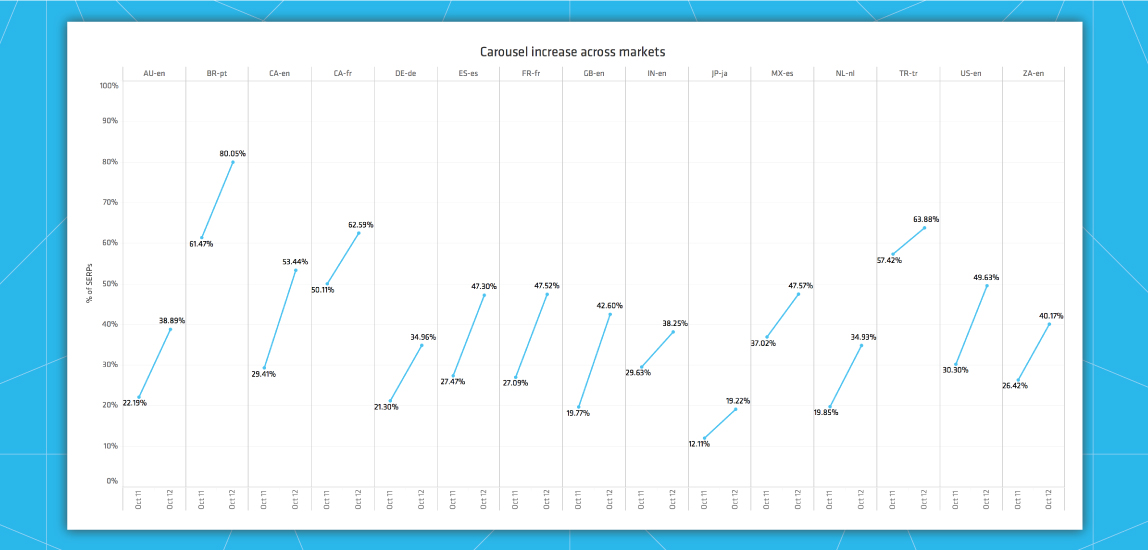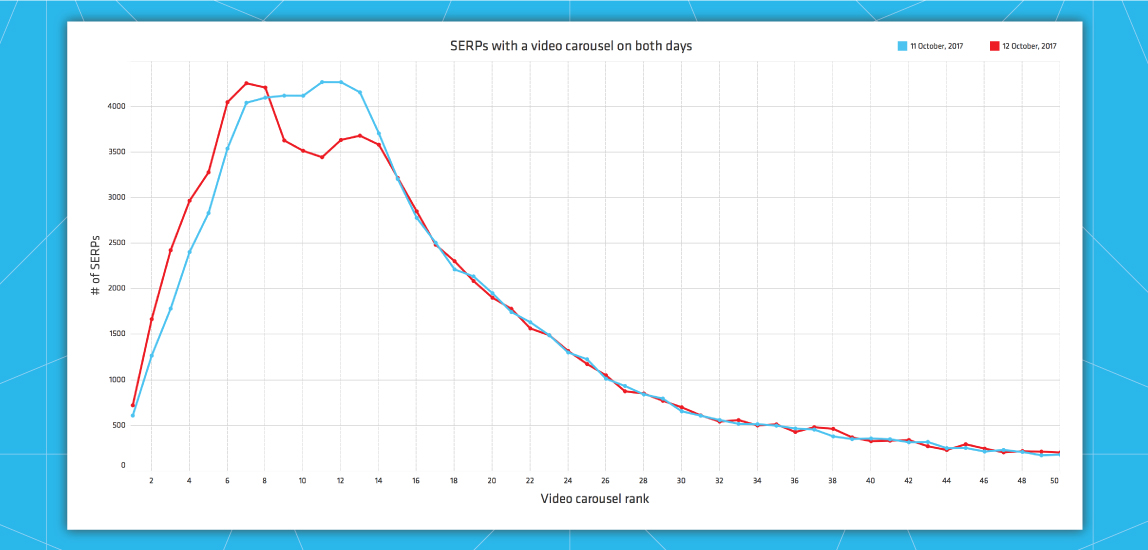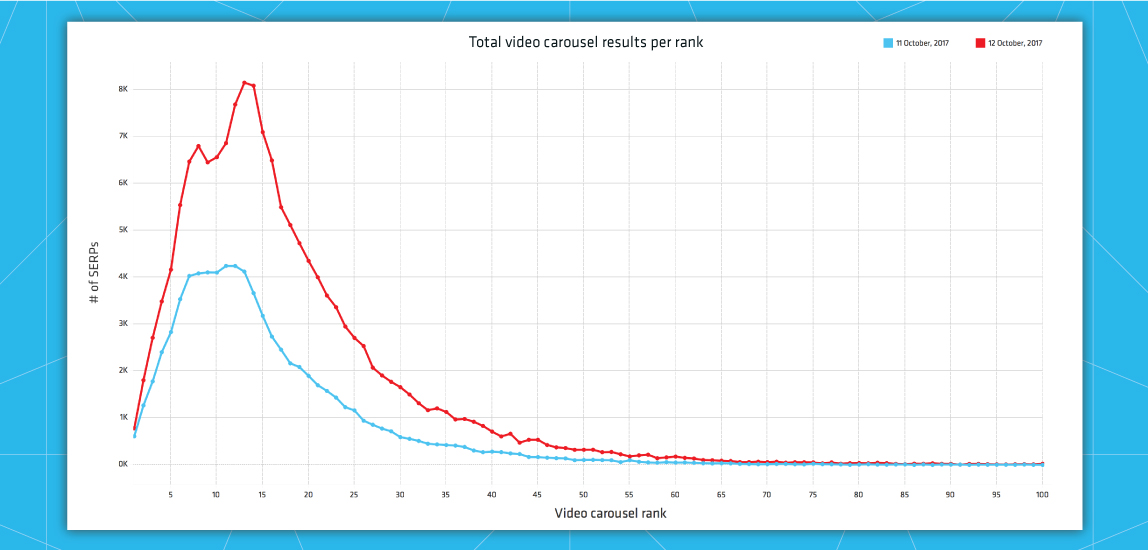After a recent Google update, video and video carousels have switched things up. We investigate what’s changed.
While we were snooping on the comings and goings of SERP features on a few sites (using our new SERP Features dashboard, natch), we spotted a massive bump in carousel results on October 12.
A big bump in carousels
Our SERP Features dashboard caught a mini-algorithm update.
We watched for a few days to see if this was just another blip on the SERP radar, and as soon as it was clear this was the new normal, we grabbed over 1.3 million mobile keywords (since that’s where carousels mostly live) to get a better understanding of what went down.
For starters, video carousels went from appearing on 23.46 percent of our keywords to 41.10 percent of them — that’s a 75.75 percent increase! Here’s what else we found:
Major (and minor) markets received a bump
Because we saw this spike while tracking in the CA-en market, our first order of business was to determine if it happened elsewhere in the world.
Playing international SEO spies, we took a random sampling of SERPs from our 15 largest markets (the smallest had around 5,000 keywords; the biggest upwards of 430,000) and plotted the percentage of carousels that they had on October 11 and October 12.
Carousels in markets across the globe
We saw the same carousel behaviour in each of our 15 largest markets.
As you can see in the image above, each market saw a hefty increase in carousels — nearly doubling in some places — from one day to the next.
Since our sampling included a number of non-English speaking countries (hi, Turkey and Brazil!), it’s likely this increase in carousels happened across all markets.
Only video carousels were at play
With market considerations out of the way, it was time to figure out exactly which carousel type Google was tinkering with — news, recipe, or video. (Or all three?)
After analysing a randomly sampled 71,678 SERPs that produced a new carousel on October 12 (i.e. SERPs without one on October 11), we learned that only 0.01 percent of those carousels contained news results and 0.09 percent contained recipe results, leaving videos in the remaining 99.90 percent.
One sharp looking video carousel
Video results typically appear in carousels more often than recipe and news results.
This wasn’t the most surprising since video results almost always hog the carousel. Together, recipe and news results typically appear in carousels 0.6 percent of the time. In this case, however, they only make up 0.1 percent of the increase.
So, while we do expect that new carousels will mostly contain videos, we don’t expect quite this many to have them, and we certainly don’t expect this many new carousels to show up all at once.
New video carousels didn’t rank high, but old ones shimmied up the SERP
Of course, just because we’re seeing more of something on the SERP, it doesn’t automatically mean we need to panic over loss in prime real estate.
When we looked at where Google placed all these new video carousels, 46.44 percent appeared on the second page, with 14 as the most popular rank to hang-out at (which isn’t exactly the most important spot).
But what about video carousels that were already chillin’ on the SERP on October 11? Did this algorithm tweak have any impact on them? Turns out it did.
Rank change in existing carousels
Video carousels got a boost in rank from October 11 to 12.
From a randomly sampled 77,644 SERPs that had a video carousel on both days, we saw that a large chunk of carousels in ranks 9–13 on October 11, suddenly found themselves distributed amongst ranks 1–8 on October 12.
Most noteworthy, ranks 1–6 had an average carousel increase of 23 percent, with ranks two and three increasing by 31 and 36 percent respectively. The largest drop in carousel count came from ranks 11 and 12 (over 14 percent each), while lower ranking carousels (in position 14 or worse) changed very little.
In other words, Google not only added new video carousels but also pushed a large number that were already present, from the second page to the first. This might actually be cause for minor concern if you’re not in the video game.
Existing video results got a boost
What we found particularly fascinating was the jump in rank that regular ol’ video results made from October 11 to 12.
Of the 71,678 randomly sampled SERPs that produced a new carousel, 85.12 percent had a video result the day before — and 86.72 percent of those videos appeared on page three or lower. On October 12, most of those videos got scooped into the new, higher ranking carousels, leaving only a few behind on the SERP.
Solo videos got scooped
A huge amount of regular video results wound up in carousels on October 12.
Coming 14th in the rank race might not feel like a win, but if you wind up there after a rank 55 finish the day before, you’ll probably feel like a champion nonetheless.
No keyword rhyme or reason
Digging into the actual queries themselves, it seems that this was an equal opportunity update — we couldn’t find anything to suggest that lexical trends or word or character count were in anyway connected to this increase in video carousels.
Key takeaways and considerations
To recap: as of mid-October, there are video carousels on roughly twice as many SERPs (in a higher position than most regular video results were), and previous video carousels are ranking even better.
What does this mean?
Look at 'em all
Video carousels nearly doubled in number on the SERP from October 11 to 12.
Well, to us, it means that Google is making a more video-prominent SERP. To you, it might mean a bit of a mixed-bag of things.
If videos are a boon to your SEO strategy, their higher spot on the SERP is likely good news. The caveat, of course, is that the further along in a carousel you sit, the lower your click-through rate is bound to be.
To determine whether this update helped or hurt you (or whether it’s worth investing in video-making), one important question to ask, track, and analyse is: does a low-ranking regular video result see more clicks than a start-, middle-, or end-of-the-line video in a carousel?
If videos are the bane of your SEO strategy, with most carousels appearing in ranks 13 and 14, there’s still plenty of room for you to get ahead. Also, we were tempted to call this new SERP-scape “video-rich,” but if most videos are being swallowed by a carousel, then they’re actually taking up less of the traditional top-down real estate, which is probably a bonus in your books.
Do you have any video carousel stats you can report post-Google update? Let us know what you’re seeing! Also let us know if you’d like to see how you can track videos, carousels, and other SERP features in STAT — say hello and request a demo.








